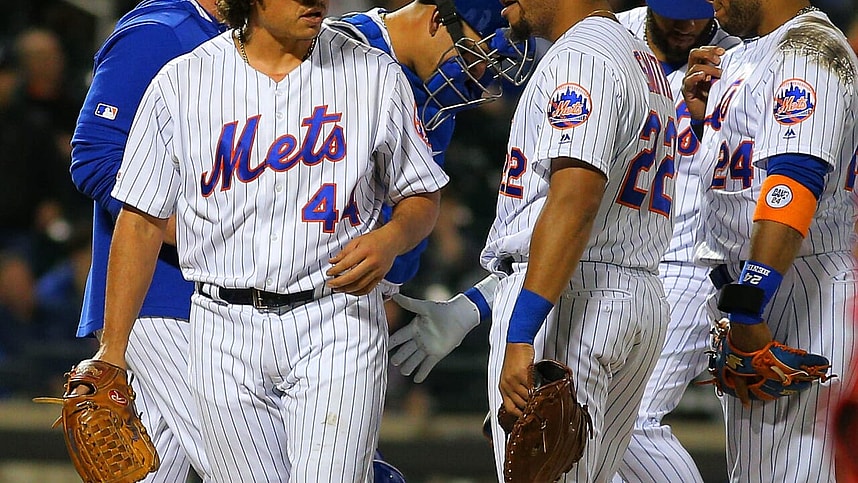
Trading Anthony Kay, Simeon Woods-Richardson, and Justin Dunn over the last year left the New York Mets‘ system a little thin when it comes to pitching prospects.
However, these arms are talented and close enough that they can reach the majors in 2020 with more consistency and a few improvements:
Five New York Mets‘ pitching prospects that can contribute next year
David Peterson, LHP
The 24-year old left-hander is arguably the Mets‘ best pitching prospect. Also, he is the closest one to making an impact in the majors as a starter.
According to Brodie Van Wagenen, the expectation is that the Mets’ 2017 first-round selection starts next season in Triple-A Syracuse, and from there, he can contribute “early in the season in 2020 potentially.”
Peterson spent the whole 2019 season in Double-A, where he had a 4.19 ERA but a much stronger 3.19 FIP. He started 24 games and pitched 116.0 frames, with a 9.47 K/9 and a 2.87 BB/9.
The young lefty will throw four pitches for strikes: a low-90s fastball, a good slider, an above-average changeup, and an average curveball. He does a fantastic job at getting grounders, which is a desirable treat for future major league success.
Franklyn Kilome, RHP
Kilome, the Mets‘ return in the 2018 Asdrubal Cabrera trade, lost all 2019 while rehabbing from Tommy John surgery. He will, most likely, be ready to roll in 2020, however, and the Mets could benefit from his talented arm.
His contributions may come as a reliever if the Mets have a need, and he can shake off the rust over the spring. If he does end up in the bullpen, his fastball-curveball combo will slot nicely there. He is certainly capable of starting, though.
His last minor-league action was in 2018 when he had 26 starts in Double-A: 19 with the Philadelphia Phillies and seven with the Mets. With New York, he registered a 4.03 ERA (3.17 FIP) in 38 frames, with a K/9 of 9.95 and a BB/9 of 2.37.
Kilome boasts a mid-90s fastball and an excellent hook. His changeup lags in development, but it has potential. His 6’6” frame often leads to command issues, but he has been successful in the past. It remains to be seen if the 24-year old can regain his stuff after surgery.
Kevin Smith, LHP
Kevin Smith is an outstanding left-handed starting pitching prospect. He dominated in Class A-Advanced ball this year (3.05 ERA, 2.63 FIP, 10.72 K/9, 2.52 BB/9) in 17 games started before a six-start stint in Double-A.
There, he was still thriving, but not dominant, as his BB/9 climbed to 4.31 and his K/9 fell to 8.04. If he manages to master the level, he will be able to jump to Triple-A over the summer, and after that, he can be a contributor to the New York Mets‘ 2020 playoffs hopes.
He has starting pitcher’s length at 6’5”. Stuff-wise, the package is enticing albeit not elite: he has a low-90s fastball, with a high spin rate, as our own Kyle Newman recently explained. The slider is the best offering, with a late bite that stifles lefties. There is also an average changeup in the repertoire.
Ryley Gilliam, RHP (reliever)
Ryley Gilliam is a flame-throwing, right-handed relief prospect that can be in Flushing come 2020. Drafted in 2018, the 23-year old already reached Triple-A in 2019 but didn’t fare too well there with a 13.50 ERA and 8.68 BB/9 in 9.1 innings.
He breezed through Class A-Advanced (2.53 ERA, 0.87 FIP in 10.2 frames with 13.50 K/9) and Double-A (4.34 ERA, 2.15 FIP, and 13.50 K/9.) He also had a nice showing in the Arizona Fall League, with a 0.96 ERA in 9.1 IP (seven games) and 11 strikeouts.
If he manages to solve Triple-A, which is a strong possibility, he will help the Mets‘ bullpen over the summer.
His upside is that of a set-up man. To help him realize it, he uses a 96-97 mph fastball and a nice curveball.
Stephen Villines, RHP (reliever)
He is barely in the Mets’ top 30 prospects list, but Stephen Villines could contribute to the New York Mets in 2020 and offer another weapon to the bullpen. He has a funky low-arm slot that makes him very difficult to square up.
Villines already mastered the Double-A level this year. There, he went 2-1 with a 1.20 ERA in 28 games (45 frames.) He fanned 42 batters and held hitters to a .209 average.
However, he only passed the Double-A test because he was demoted after such a dismal showing in Triple-A. With Syracuse, he had a 6.75 ERA and an ugly 1.94 WHIP, with an 8:12 BB:K ratio.
If he is to make a splash with the Mets in 2020, he needs to do well in Triple-A first. However, there is a strong possibility he makes it.
Villines throws an upper-80s fastball that plays up because of his arm slot. The slider is effective, but the changeup is better. The most important thing is that he can throw all of them for strikes, which bodes well both for him and for the Mets.
More about: New York Mets